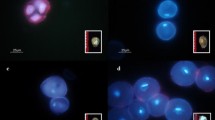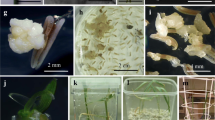Abstract
Anthers cultures of six Polish cultivars of pasture lupin (Lupinus L.) were examined for their androgenic response. Anthers with microspores at the uninucleate stage were isolated from flower buds and cultured in liquid media. Better viability of androgenetic structures was obtained when donor plants had grown under field as opposed to greenhouse conditions. A density of five anthers per 0.5 ml medium was more conducive to androgenetic induction than 25 anthers per 0.5 ml medium. Addition of 5% maltose to the induction medium and culture at 25°C without pre-treatment of flowers, buds or anthers promoted microspore release and division. The greatest frequency of androgenic callus, ~70% was developed from cvs. Katon, Wat (white lupin), in contrast to cvs. Legat, Juno (yellow lupin), Polonez and Sonet (narrow-leafed lupin) with callus induction ~30–40%. Despite various combinations of media tested, plant regeneration was not obtained from anther derived callus.






Similar content being viewed by others
References
Bajaj YPS, Gosal SS (1987) Pollen embryogenesis and chromosomal variation in cultured anthers of chickpea. Int Chickpea Newsl 17:12–13
Bayliss KL, Wroth JM, Cowling WA (2004) Pro-embryos of Lupinus spp. produced from isolated microspore culture. Aust J Agric Res 55:589–593
Cardoso MB, Kaltchuk-Santos E, Mundstock EC, Bonadese-Zanettini MH (2004) Initial segmentation patterns of microspores and pollen viability in soybean cultured anthers: indication of chromosome doubling. Braz Arch Biol Technol 47:703–712
Croser JS, Lulsdorf MM, Davies PA, Clarke HJ, Bayliss KL, Mallikarjuna N, Siddique KHM (2006) Toward doubled haploid production in the fabaceae: progress, constraints, and opportunities. Crit Rev Plant Sci 25:139–157
Custers JBM, Cordewener JHG, Fiers MA, Maassen BTH, Van Lokeren Campagne MM, Liu CM (2001) Androgenesis in Brassica. A model system to study the initiation of plant embryogenesis. In: Bhojwani SS, Soh WY (eds) Current trends in the embryology of angiosperms. Kluwer Academic Publishers, Dordrecht, pp 451–470
Datta SK (2001) Androgenesis in cereals. In: Bhojwani SS, Soh WY (eds) Current trends in the embryology of angiosperms. Kluwer Academic Publishers, Dordrecht, pp 471–488
de Moraes AP, Bonadese-Zanettini MH, Callegari-Jaques SM, Kaltchuk-Santos E (2004) Effect of temperature shock on soybean microspore embryogenesis. Braz Arch Biol Technol 47:537–544
Gamborg OL, Miller RA, Ojima K (1968) Nutrient requirements of suspension cultures of soybean cells. Exp Cell Res 50:151–158
Góralski G, Matthys-Roschon E, Vergne P, Przywara L (1999) Androgenic development: a fascinating embryo formation process. Acta Biol Crac 41:51–65
Huda S, Islam R, Bari MA, Asaduzzaman M (2001) Anther culture of Chickpea. Int Chickpea Pigeonpea Newsl 8:24–26
Indrianto A, Barinova I, Touraev A, Heberle-Bors E (2001) Tracking individual wheat microspores in vitro: identification of embryogenic microspores and body axis formation in the embryo. Planta 212:163–174
Kaltchuk-Santos E, Mariath JE, Mundstock E, Hu Ch, Bodanese-Zanettini MH (1997) Cytological analysis of early microspore division and embryo formation in cultured soybean anthers. Plant Cell Tissue Organ Cult 49:107–115
Kaur P, Bhalla JK (1998) Regeneration of haploid plants from microspore culture of pigeonpea (Cajanus cajan L.). Indian J Exp Biol 36:736–738
Khan SK, Ghosh PD (1983) In vitro induction of androgenesis and organogenesis in Cicer arietinum L. Curr Sci 52:891–893
Kruczkowska H, Pawłowska H, Skucińska B (2002) Influence of anther pretreatment on the efficiency of androgenesis in barley. J Appl Genet 43:287–296
Lauxen MS, Kaltchuk-Santos E, Hu Ch, Callegari-Jaques SM, Bonadese-Zanettini MH (2003) Association between floral bud size and developmental stage in soybean microspore. Braz Arch Biol Technol 46:515–520
Małuszyński M, Kasha KJ, Forster BP, Szarejko I (eds) (2003) Doubled haploid production in crop plants—a manual. Kluwer Academic Publishers Dordrecht, pp 428
Marciniak K, Banaszak Z, Wędzony M (1998) Effect of genotype, medium and sugar on triticale (×Triticosecale Wittm.) anther culture response. Cereal Res Commun 26:145–151
Muñoz-Florez LC, Baudoin JP (1994a) Anther culture in some Phaseolus species. In: Roca WM, Mayer JE, Pastor CMA, Tohme MJ (eds) International scientific meeting phaseolus beans advanced biotechnology research network (2:1983: Cali, Colombia). Phaseolus beans advanced biotechnology research network: proceedings. Centro Internacional de Agricultura Tropical (CIAT), Cali, CO, pp 205–212
Muñoz-Florez LC, Baudoin JP (1994b) Influence of the cold pretreatment and the carbon source on callus induction from anthers in Phaseolus. Bean Improvement Cooperative. Annual Report (USA) 37:129–130
Murashige T, Skoog F (1962) A revised medium for rapid growth and bioassays with tobacco tissue cultures. Physiol Plant 15:473–497
Nitsch JP, Nitsch C (1969) Haploid plants from pollen grains. Science 163:85–87
Ormerod AJ, Caligari PDS (1994) Anther and microspore culture of Lupinus albus in liquid medium. Plant Cell Tissue Organ Cult 36:227–236
Peters JE, Crocomo OJ, Sharp WR, Paddock EF, Tegenkamp I, Tegenkamp T (1977) Haploid callus cells from anthers of Phaseolus vulgaris. Phytomorphology 27:79–85
Puolimatka M, Pauk J (2000) Effect on induction duration and medium composition on plant regeneration in wheat (Triticum aestivum L.) anther culture. J Plant Physiol 156:197–203
Reynolds TL (1997) Pollen embryogenesis. Plant Mol Biol 33:1–10
Rodrigues LR, Terra TF, Bered F, Bodanese-Zanettini MH (2004) Origin of embryo-like structures in soybean anther culture investigated using SSR marker. Plant Cell Tissue Organ Cult 77:287–289
Sator C (1985) Plant regeneration for anthers of lupins. Landbauforschung Volkenrode 35:5–7
Sator C, Mix G, Menge U (1983) Investigation on anther culture of Lupinus polyphyllus. Plant Res Dev 18:37–46
Schenck RV, Hildebrandt AC (1972) Medium and techniques for induction and growth of monocotyledonous plant cell cultures. Can J Bot 50:199–204
Scott P, Lyne RL, Rees T (1995) Metabolism of maltose and sucrose by microspores isolated from barley (Hordeum vulgare L.). Planta 197:435–441
Smykal P (2000) Pollen embryogenesis—the stress mediated switch from gametophytic to sporophytic development. Current status and future prospects. Biol Plant 43:481–489
Tanner GJ, Piccirilli M, Moore AE, Larkin PJ, Arcioni S (1990) Initiation of non-physiological division and manipulation of developmental pathway in cultured microspores of Medicago sp. Protoplasma 158:165–175
Vessal SR, Bagheri A, Safarnejad A (2002) The possibility of in vitro haploid production in chickpea (Cicer arietinum L.). J Sci Technol Agric Nat Resour 6:67–76
Ye XG, Fu YQ, Wang LZ (1994) Study on several problems of soybean anther cultures. Soybean Sci 13:193–199
Zagorska N, Dimitrov B (1995) Induced androgenesis in alfalfa (Medicago sativa L.). Plant Cell Rep 14:249–252
Acknowledgement
This study was supported by COST 851 23/E –189/SPB/COST/P-06/DZ 585/2002-2005.
Author information
Authors and Affiliations
Corresponding author
Rights and permissions
About this article
Cite this article
Skrzypek, E., Czyczyło-Mysza, I., Marcińska, I. et al. Prospects of androgenetic induction in Lupinus spp.. Plant Cell Tiss Organ Cult 94, 131–137 (2008). https://doi.org/10.1007/s11240-008-9396-7
Received:
Accepted:
Published:
Issue Date:
DOI: https://doi.org/10.1007/s11240-008-9396-7




